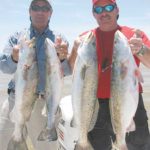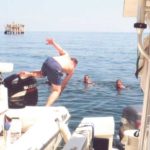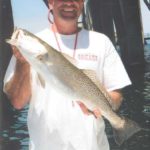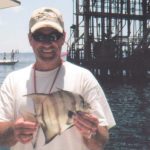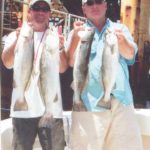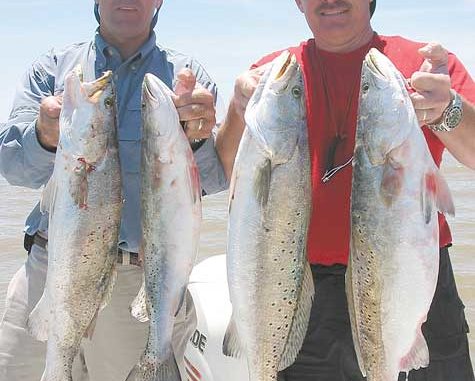
Head to the rigs waaaaaay out in Breton Sound if you want easy specks this time of year.
You don’t see many houseboats with hot tubs.
“Leave it to Doc Fontaine to break new ground,” Pelayo said as he, Chris and I clamped up the stairs to the houseboat deck. And it’s not like his two-story Venice houseboat wasn’t ritzy enough without it.
“Roughing it,” just ain’t in Doc’s vocabulary — not since he got out of medical school, anyway. That sleeping out on the sand atop a beer- and rum-soaked blanket with filthy sneakers for a pillow was fine for Spring Break 1979 in Panama City out back of a place called Spinnaker.
But it ain’t gonna cut it nowadays. Besides, he had no choice back then. The gals we met from Auburn had thrown him out of their room. We’d locked him out of ours. And right around midnight, the pot-bellied security guard from the hotel had urged him off the pool chair with a little poke from his nightstick followed by an invigorating blast of pepper gas.
“A fool-proof eye-opener,” the rent-a-cop chuckled with us the next morning as he shamelessly rifled beers from our ice chest.
But Doc’s eyes had looked like crushed kiwi fruits when we finally opened the door and let our gasping, stumbling Tigerland room-mate into the crowded hotel room.
Actually, we had all tried to sleep on the beach. It always seemed like a keen idea around midnight, during the third jug of margaritas, with the moon-dappled swells heaving gently before us, with the soft gurgling as they foamed and surged over the sand, with Rod Stewart croaking his “Tonight’s the Night” from the boombox and with the gals we’d met the night before at Spinnaker finally getting pink-cheeked, giggly and snuggly.
Three hours later, with the sand rubbing our sunburns, the bugs biting, the boom-box’s batteries dead and our heads starting to throb, a chilled hotel room, soft mattress and crisp sheets seemed like just the ticket. So we all staggered off that miserable, wretched beach, and upstairs to bliss.
Nowadays, when visiting Venice, we head straight to Doc’s houseboat and luxurious bliss. On the 30th anniversary of that fascinating Florida weekend, 12 old Tigerland college chums would converge at Doc’s for three days of serious fishing, serious revelry and serious reminiscing. A full 10 of us had been present at the Panama City gig. So the reminiscing would surely crank into high gear, plenty of “inside” stuff.
On top of the luxuries, it would be difficult to imagine a more centrally located fishing headquarters than Doc’s houseboat. Out of Venice and with 20-foot-plus boats, the options are mind-boggling. Out to Breton Island and Breton Sound for specks? To the Canyon or Lump for tuna and wahoo? To Blind and Redfish bays for specks and reds? To the spillways for reds? Out through Red Pass to the shallow West Deltas for pompano, Spanish and mangroves? To the roseau coastline from Grand Pass around to Red Pass for redfish action?
The options — all delicious to contemplate — can drive a fanatical fisherman dizzy. No fishing locale in America offers such diversity, not even close. Alas, on this late-spring weekend, super-high river levels eliminated fully half the options.
The evening was cranking up on Doc’s deck when, “Perry!” Chris roared while noticing the figure clumping up the stairs with two grocery bags. “What the hell you doin’ down here?”
“Yeah,” Pelayo laughed. “We heard you were in prison?”
Behind Perry came the rest of the gang. They’d come down in two vehicles. Now the merriment cranked up several notches. The same high winds that would make for tough fishing made the night wonderful, cool (for an evening in coastal Louisiana) with no bugs.
Amazingly, we soon noticed that the racket on a nearby houseboat was outdoing ours.
We looked over from the railing and saw people waving at us between dances. Most looked female. Then we noticed the two who’d been waving scurry around their railing.
In seconds they’d stomped up Doc’s stairs.
“Come on, guys!” they shrieked “Party’s just startin’!!”
We didn’t require much prodding. Once on their deck, it only took seconds to note that the gals were taking full advantage of the glorious weather, all decked out in hip-riding short-shorts, skimpy tops and flip-flops. Most were dancing. All were pink-cheeked and giggly while holding drinks.
I was trying to get a handle on the scene when I felt my arm jerked.
“Let’s go, big guy!” yelled a curvaceous brunette in hoop earings and a skimpy tank-top that terminated well north of her navel. “Time to shake a leg!”
Half my beer spilled as I was dragged to the middle of the impromptu dance floor (back deck of their houseboat) where Chris, Pelayo, Perry, Johnny and Howie were already weaving and gyrating like maniacs.
K.C.’s “Shake your Booty” boomed from the speakers. And his admonition was being very well-received. I noticed a tattoo of some kind on Chris’ dance mate, right at the base of the spine, between the dimples. Mine had one above her ankle.
Some crazy shouts turned my head, and I looked over at Bob, Johnny and Pelayo, gyrating madly and singing with the same fervor as their dance partners. It wasn’t taking long to get into the spirit of things. The song ended and the gals all handed us fresh drinks. We sat for a bit, still a bit disoriented by the scene, when suddenly the gal in the minuscule cut-offs they called Jenny rushed over to the boom box and slipped in a new CD.
Thelma Houston’s “Don’t Leave Me This Way” suddenly boomed from the speakers. Jenny whooped, turned around with a wicked smile, lifted her arms overhead and started strutting her stuff. The “dance floor” filled with gals thrusting their hips and shaking their bosoms with complete abandon, while singing along at top decibel. “Baby! My heart is filled with desire for you!”
Some whoops and claps jerked my head around, and I saw a circle had formed. Sure enough, both Howie and Doc were in the middle trying to outdo each other while poppin’ the ’gator. With all the racket, I figured we’d all be getting booted out of the marina in short order. But no, the lunacy proceeded and got even crazier.
Nobody talked much as we boarded the boats the next morning, even though it was 10 a.m. All was quiet as our armada of three boats cruised down Baptiste Collette, Breton Sound-ward. The chatter on the radio was low-key and perfunctory.
From the Ostrica locks down to Baptiste Collette, the levee-less east bank of the river is sliced by over a dozen breaks nowadays. Natural mini-diversion projects, you might call them — and wonderful news for this area of of coastal marsh. The effects of sediment-rich Mississippi River water (that magic elixir) in rejuvenating and building-up this section of marsh are abundantly visible and downright exhilarating. Alas, during periods of high river levels, this means getting way out into Breton Sound to find fishable water.
Our trip coincided with one of these periods. And I mean high-river with bells on. So out we pounded, and pounded, and pounded.
First stop was (what’s left of) Breton Island. A half hour of dunking Carolina-rigged live shrimp along the lee side yielded two gafftops, so we moved on to the famous structure known as “The Central,” long a favorite for Breton Sound trout aficionados. Our haul to this structure, however, was nothing compared to the haul when reaching this rig from Hopedale or Delacroix, which is probably how a majority of fisherpersons get out here.
They call it The Central for a reason. We idled around it looking for an opening. Already a fleet had converged and anchored around it. They had come from all points of the compass.
“Guy over there is netting another one!” Chris gasped from the bow while pointing at a twin-V anchored on the very corner of the rig. He was the only one who we’d seen catch anything. Now he was netting his third trout in the few minutes we’d been putting around with the trolling motor trying to look nonchalant. “Looks like our spot.”
So we snuck in from his blind side.
“You crazy?”
I looked over at the twin-V guy, no more than 50 feet away now. He threw down his pole and was waving his arms at us while screaming something.
“Nice!” raved his buddy, who’d just netted a gorgeous speck. “Real nice!”
Howie turned the trolling motor to gain a little distance from the distraught fellow. Then I noticed another boat creeping up on the twin-v. This one bracketed them from the other side, about as close as we were. And another boat was right behind them.
Here was a classic Breton Sound trout situation. You see it from The Wreck, through Battledore and, most notoriously, here at the Central — somebody mopping up on one little corner of the structure, nobody else catching jack.
One explanation may be current flow. From diving, we know that most fish tend to congregate on the upcurrent side of a rig. LSU’s wetland center did a study dropping some kind of a sonar contraption around rigs and confirmed it.
Problem is, at the deeper rigs you never really know which way the current’s going down where your bait is. The currents in the Gulf are often layered — going in one direction for the first 10 to 50 feet from the surface, then the switching in the opposite direction. Then maybe back again at real deep rigs. It’s weird. Scuba divers know this.
You almost always hook up to a rig on the downcurrent side, so you wont get battered against the beams. An exception might be with a slack current (on the surface) and a stiff wind. Here the wind determines how your boat will position itself. So even while hooking up downcurrent of a rig, your bait might get pushed close to or actually inside the platform’s structure, which is what you want, what often happens at deeper rigs.
A trolling motor helps ameliorate this problem — at least it did for us because the current would have bashed us into the rig if we’d used the traditional rig-hook. We managed to hover around the hot trout-action corner of the rig without provoking a flare-gun shoot-out with the boats in the area, though it came close at times.
Perry was the first to cast with a live shrimp on a sliding cork. In half a minute, the cork plunged. I looked up, and his medium spinning rod was bowed over beautifully. Then it started jerking from brutal lunges characteristic of big specks. Then a big trout exploded on the surface in a gorgeous froth as Pelayo whooped from the bow with another.
“Somebody better get the net!” Perry’s face was creased in a gargantuan smile. The first we’d seen all morning, from anyone. I netted Perry’s trout a minute later — about a 3-pounder.
Now Chris was whooping from the stern as a big trout whipsawed his ultra-light rod. I finally hooked a live shrimp through the horn and nailed a nice speck not fifteen seconds after it hit the water about 20 feet from the rig’s corner.
Then I got three snags trying Carolina rigs. The bottom around this rig seems heavily littered with snags, probably from all the recent hurricanes. I finally relented and went over to the sliding cork while my three chums had been battling speck after speck that had been plunging theirs.
After a while, I noticed the specks caught on the croakers averaged slightly bigger than those caught on live shrimp. All of the 30 we boated ranged from 2 to 4 pounds. Three were over 5, which freaked us out. We caught trout steadily for an hour and a half — for exactly as long as the live shrimp and croakers lasted. Then we caught a few puppy drum and sheepshead on dead shrimp — but nary a speck. Not one. Not one on artificials either.
Next stop was the platform known as “The Holy Cross,” which lies about five miles east of the Central. Now we were getting way out, technically into Chandeleur Sound. Johnny headed there as his first stop and informed us via radio that the trout action was hot and heavy — and all on plastic.
Indeed we pulled up close to him, Chris plopped over the trolling motor and the first four casts with purple cocahoes (bounced along the bottom) yielded two trout. At the Central, plastic had yielded exactly nothing. The trout were much less finicky here at the Holy Cross, and over the next three hours readily took plastic (Dudleys, Cocahoes, Gulps in a variety of colors with pinkish hues taking top honors.)
Indeed, think about it. Who fishes with live bait at the Chandeleur Islands? Surely it’s not commonplace. In fact the very purpose of making the haul out to that pristine chain of islands is to catch huge trout — preferably wading — with artificials. There’s just a special buzz that comes from getting a strike while reeling in a lure that surpasses the buzz from reeling in a big speck that smacked a live shrimp or croaker.
In general, the farther you get away from fishing pressure the greater the likelihood that big specs will hit artificials. Oh I know, I know, I know, super-proficient specialists manage to haul in absolutely eye-popping catches of huge specks on plastic in heavily-fished Lake Pontchartrain waters.
But I’m talking Joe-the-Plumber fisherguys here. Generally speaking if we fish the Trestles, Causeway, even Grand Isle surf or Timbalier and Last Island, and want consistent action with respectable specks, we’ll use live bait, as will most guides in Southeast Louisiana.
Point is, the farther we got out into Breton and Chandeleur sounds (and the more gas we burned), the more the specks fell for plastic. It doesn’t seem like rocket science to speculate that trout simply see less of it out in these butt-pounding extremes, and thus more readily equate it with natural food.
The well-jackets around the Holy Cross also yielded respectable specks as we trolled around them casting various plastics.
In sum, the trout bites came late in the evening with the falling current. And by employing the trolling motor, we were able locate their hotspots around structures much more easily than by hooking and unhooking, anchoring and lifting anchor.
In brief, outer Breton Sound lived up to its reputation as a summer speck hotspot.
